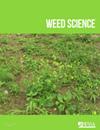为特定时间的杂草管理建立杂草出苗模型:系统综述
IF 2.1
2区 农林科学
Q2 AGRONOMY
引用次数: 0
摘要
了解杂草的出苗时间对有效管理至关重要。过早实施管理措施可能无法完全控制晚出苗的杂草,而过晚实施管理措施则会导致效果不佳。杂草出苗时间反映了种子休眠和发芽要求等生物因素以及环境条件。我们对建立模型预测杂草出苗时间模式的研究进行了系统回顾。我们筛选了 1854 项研究,其中 98 项被纳入最终数据集。大多数研究都是在北美(51 项)或欧洲(30 项)进行的。纳入的杂草种类(102 种)和科(21 个)多种多样,许多研究对多种杂草进行了建模。禾本科杂草(Poaceae)最常见(83 例)。大多数杂草(40%)的基础温度 T b 值在 0 至 5 C 之间,38% 的杂草的基础水势 ψ b 值在 -1.0 至 -0.5 MPa 之间。大多数研究采用经验参数模型,如 Weibull(40%)或 Gompertz(30%)模型。也有非参数模型和机理模型。模型对生物和环境数据的要求各不相同。一般来说,基于热液时间(即高于基础温度和水势阈值的时间)的经验参数模型在易用性和预测准确性之间取得了良好的平衡。人工神经网络等软计算方法在出现复杂模式和数据有限的情况下显示出巨大的潜力,尽管它们容易出现过度拟合。我们的研究还显示了模型性能的可变性以及在不同物种和地区之间的有限通用性。这一发现突出表明,特别是在气候变化的背景下,需要针对具体情况并经过充分验证的杂草出现模型来为管理提供信息。本文章由计算机程序翻译,如有差异,请以英文原文为准。
Modeling weed seedling emergence for time-specific weed management: a systematic review
Understanding the timing of weed emergence is crucial to effective management. Management practices implemented too early may fail to completely control late-emerging seedlings, whereas management practices implemented too late will suffer from low efficacy. Weed emergence times reflect biological factors, such as seed dormancy and germination requirements, as well as environmental conditions. We conducted a systematic review of studies that developed models to predict weed emergence temporal patterns. We screened 1,854 studies, 98 of which were included in the final dataset. Most included studies were conducted in North America (51) or Europe (30). A wide variety of weed species (102) and families (21) were included, and many studies modeled several weeds. Grass weeds (Poaceae) were modeled most frequently (83 instances). Most weeds (40%) had base temperature T
b
values between 0 to 5 C and 38% had base water potential ψ
b
ranging from -1.0 to -0.5 MPa. Most studies used empirical parametric models, such as Weibull (40%) or Gompertz (30%) models. Non-parametric and mechanistic models were also represented. Models varied in their biological and environmental data requirements. In general, empirical parametric models based on hydrothermal time (i.e., time above base temperature and water potential thresholds) represented a good balance between ease of use and prediction accuracy. Soft computing approaches such as artificial neural networks demonstrated substantial potential in situations with complex emergence patterns and limited data availability, although they can be susceptible to overfitting. Our study also demonstrated variability in model performance and limited generalizability across species and regions. This finding underscores the need for context-specific and well-validated weed emergence models to inform management, especially in the context of climate change.
求助全文
通过发布文献求助,成功后即可免费获取论文全文。
去求助
来源期刊

Weed Science
农林科学-农艺学
CiteScore
4.60
自引率
12.00%
发文量
64
审稿时长
12-24 weeks
期刊介绍:
Weed Science publishes original research and scholarship in the form of peer-reviewed articles focused on fundamental research directly related to all aspects of weed science in agricultural systems. Topics for Weed Science include:
- the biology and ecology of weeds in agricultural, forestry, aquatic, turf, recreational, rights-of-way and other settings, genetics of weeds
- herbicide resistance, chemistry, biochemistry, physiology and molecular action of herbicides and plant growth regulators used to manage undesirable vegetation
- ecology of cropping and other agricultural systems as they relate to weed management
- biological and ecological aspects of weed control tools including biological agents, and herbicide resistant crops
- effect of weed management on soil, air and water.
 求助内容:
求助内容: 应助结果提醒方式:
应助结果提醒方式:


